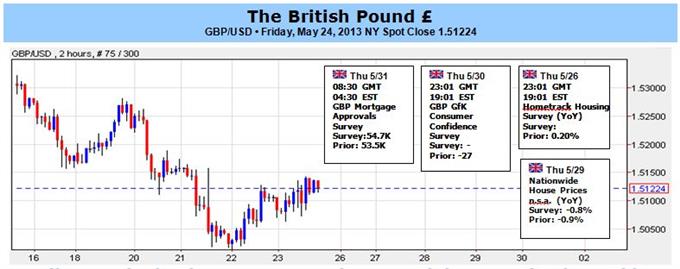
Sterling Stumbles as Disinflation Accelerates; Light Week Ahead
Fundamental Forecast for British Pound: Neutral
EUR/GBP Technical Analysis 05.24.13
Forgetting Ben (Bernanke) and Trading the Yen Next Week
GBP/USD Reverses off of 4/4 Low
The British Pound was one of the worst performing currencies this past week, barely outpacing the Australian and Canadian Dollars, by +0.53% and +0.08%, respectively. The dramatic turnaround in both of the more traditional safe havens, the Japanese Yen and the Swiss Franc, came amid an equally dramatic sell-off in equity markets around the globe, which seemed to have cost the Sterling some favor among traders; as the world’s oldest and more liquid currencies, the Euro-zone crisis sans the Swiss Franc as a viable safe haven opened the door for the Sterling to fill the void. Hence, as the globe shifted back into the traditional safe havens and Euro-zone concerns on hold, the British Pound had to pay the piper.
Exogenous influences weren’t the only reason the British Pound fell, however. Data this past week showed that disinflation – positive but decelerating price pressures – is kicking in, with the April Consumer Price Index report showing a considerable drop to +2.4% y/y, the lowest such rate since September. In all, there have been only two CPI reports showing headline inflation at +2.4% y/y or less over the past three years, besides the April reading: June 2012 at +2.4% y/y and September 2012 at +2.2% y/y. Comparatively speaking, it is worth pointing out that the British Pound gained in the three months following those reports. After the June report, the GBPUSD gained +2.85% through the end of September; after the September report, the GBPUSD gained +0.54% (this is slightly distorted by burgeoning Yen weakness, as the GBPJPY soared by +10.62% in the 4Q’12).
The big picture to consider with the weaker than anticipated inflation numbers which, by the way, caused the GBPUSD to accelerate its slide to a weekly low of $1.5031, in what was the closest pass at 1.5000 since April 4, when price slumped to 1.5032 (note: a former low holding). Inflation has remained a concern for the Bank of England, which has held off from any significant easing measures of its own (significant being a relative term thanks to the actions of the Bank of Japan and the Federal Reserve).
As per the BoE’s May meeting Minutes that were released this week, “domestic cost pressures were likely to ease over the forecast period as productivity growth gradually revived. Medium-term inflation expectations were assumed to remain anchored on the target. And external pricing pressures were assumed to fade. Overall, those assumptions meant that inflation was set to fall back gradually over the forecast period.Even so, inflation was more likely than not to be above the 2% target for much of the next two years.”
Inflation is the most important issue to focus on during the week ahead, as there is a relatively light economic docket, and now that disinflation has set in, the BoE might start to change its tune – soon. Governor Mervyn King is out the door in July, after which point Mark Carney will take the reins. Governor Carney has been an advocate of non-traditional easing measures when central bank policies have reached their traditional limits – zero or near-zero interest rates. If this trend of disinflation continues, then there is a good chance that the incoming governor expands the BoE’s accommodative policies via other avenues, perhaps even a nominal GDP target.
For now, as the market weighs the pros and cons of what the new price data means in context of a slowly growing economy, the British Pound is viewed as neutral, especially in context of some of the more violent moves occurring in the FX landscape presently. Technically speaking, the EURGBP broke out of its downtrend off of the March 12 and April 17 highs, while the GBPUSD has slid to its lowest level in nearly two months. With the GBPCHF and GBPJPY pairs in turmoil as well, the British Pound is seemingly paralyzed by the lack of policy response on either the fiscal or monetary side of the equation, leaving it in a precarious position in the weeks ahead. -CV
DailyFX provides forex news and technical analysis on the trends that influence the global currency markets.Learn forex trading with a free practice account and trading charts from FXCM.
Source: Daily fx